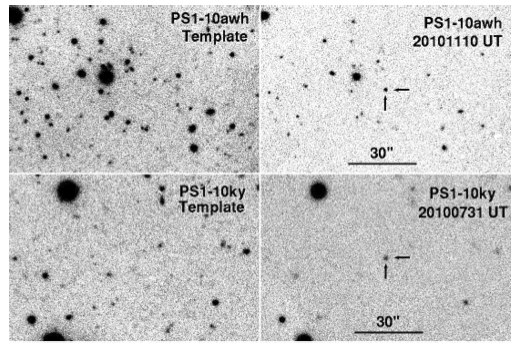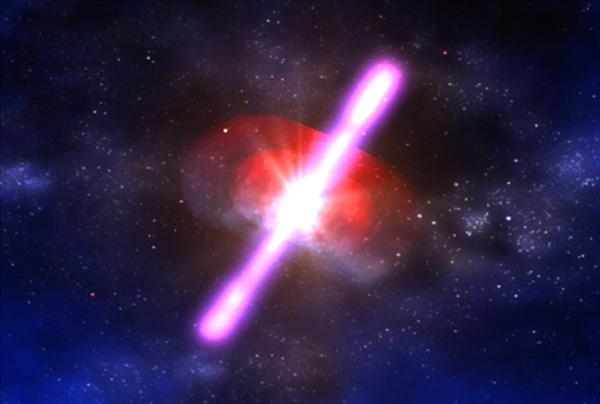Extemely Luminous, Distant, and Mysterious Explosions Discovered by Pan-STARRS1
October 4th, 2011 by laurachomiukRecently, astronomers have discovered a new class of very bright—and very mysterious—stellar explosions. These events rank as the most luminous supernovae known, more than ten times brighter than the normal supernova explosions which mark the deaths of massive stars. Curiously, these explosions show no evidence for the two most common elements in the universe: hydrogen or helium. Instead, their spectra show the much rarer elements (in the universe on average—although not on earth) of carbon, oxygen, and magnesium. In addition, the colors of these supernovae are very blue, peaking at ultraviolet wavelengths where our eyes are not sensitive and the Earth’s atmosphere blocks radiation.

Images taken before (left) and after (right) explosion, for the two ultra-luminous SNe recently discovered by Pan-STARRS1, PS1-10ky and PS1-10awh.
While this class of explosions was first recognized in the local universe by the Palomar Transient Factory, Pan-STARRS1 has been identifying them at significant cosmological distances and redshifts. We just completed a study of two of these “ultra-luminous” supernovae at a redshift of ~1, which means that these supernovae exploded when the universe was just half the age it is today. It also means they are very far away—you can imagine that they must be very luminous explosions indeed, if we can detect the death of a single star at distances of 18 billion light years! Conveniently, when we observe these sources at such large distances, their spectra get shifted towards redder wavelengths by the cosmological expansion of the universe, so that the ultraviolet peak of their spectra is shifted to visible wavelengths that are visible through the atmosphere. This helps us discover them at these great distances, and also allows us to study the part of their spectra where most of the energy comes out. Pan-STARRS1 is continuing to find approximately one of these rare explosions each month, greatly expanding the number known and allowing us to trace how this class of extremely bright explosions evolves over cosmic time. We note that most of these ultra-luminous supernovae discovered by Pan-STARRS1 have been “orphans”, without a clear host galaxy; targeting orphaned supernovae often turns up particularly interesting transients, as described in this other blog post.

Artist’s impression of a supernova powered by an extra “engine”—perhaps a magnetar (Courtesy of NASA/D. Berry).
Typically in a supernova explosion, only ~10% of the energy of the explosion is transformed into light. The rest of the energy goes into heat and the motion of expansion. We think it’s possible to get ten times more light out of a supernova in two ways: either all of the explosion’s energy is transformed into light, or there is an extra source of energy that boosts the total explosion energy of the supernova. The first popular explanation for these ultra-luminous explosions touches on point (a): the supernova blast interacts with a dense envelope of material that surrounds the exploding star, and this strong interaction makes the blast wave dump all of its energy into radiation in one relatively rapid burst. The second popular explanation exploits possibility (b): when the star explodes, it leaves behind a rapidly-spinning, highly-magnetic remnant called a magnetar. This magnetar then rapidly spins down, and transfers the rotational energy that it is losing to the supernova explosion. In this way, the magnetar is an “engine” that gives the supernova extra power. As of today, both of these explanations have strengths, and both have weakneses. In the months to come, as we discover more of thse powerful explosions, we will better understand which, if either, of these explanations is most likely—or additional possible explanations will surface. However, for the moment, the cause of thse extremeley energetic explosions remains a mystery.










